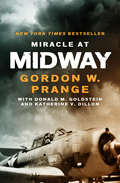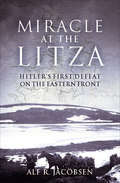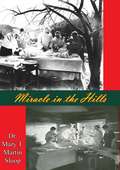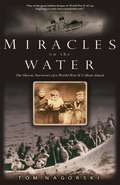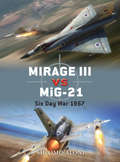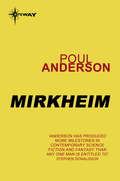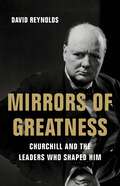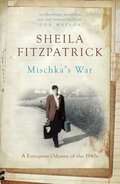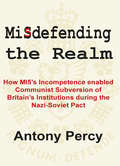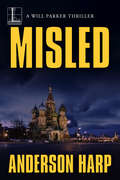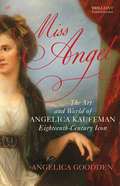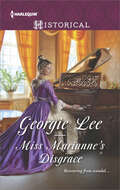- Table View
- List View
Miracle at Midway
by Gordon W. Prange Donald M. Goldstein Katherine V. DillonNew York Times bestseller: The true story of the WWII naval battle portrayed in the Roland Emmerich film is &“something special among war histories&” (Chicago Sun-Times). Six months after Pearl Harbor, the seemingly invincible Imperial Japanese Navy prepared a decisive blow against the United States. After sweeping through Asia and the South Pacific, Japan&’s military targeted the tiny atoll of Midway, an ideal launching pad for the invasion of Hawaii and beyond. But the US Navy would be waiting for them. Thanks to cutting-edge code-breaking technology, tactical daring, and a significant stroke of luck, the Americans under Adm. Chester W. Nimitz dealt Japan&’s navy its first major defeat in the war. Three years of hard fighting remained, but it was at Midway that the tide turned. This &“stirring, even suspenseful narrative&” is the first book to tell the story of the epic battle from both the American and Japanese sides (Newsday). Miracle at Midway reveals how America won its first and greatest victory of the Pacific war—and how easily it could have been a loss.
Miracle at St. Anna
by James McBrideFROM THE MILLION-COPY BESTSELLING AUTHOR OF THE HEAVEN & EARTH GROCERY STORE 'I envy those about to discover Miracle at St. Anna for the first time'Bonnie Garmus, author of Lessons in Chemistry'Searingly, soaringly beautiful'Baltimore SunTowards the end of World War Two, four soldiers from the Army's Negro 92nd Division find themselves separated from their unit behind enemy lines.Risking their lives for a country in which they are treated with less respect than the enemy they're fighting, they discover humanity in the small Tuscan village of St. Anna di Stazzema - in the peasants who shelter them, in the unspoken affection of an orphaned child.Now a major film directed by Spike Lee, Miracle at St. Anna is an unforgettable tale of courage and redemption set in Second World War Italy, from internationally bestselling novelist James McBride.WITH A NEW INTRODUCTION BY BONNIE GARMUS
Miracle at St. Anna
by James McBrideFROM THE MILLION-COPY BESTSELLING AUTHOR OF THE HEAVEN & EARTH GROCERY STORE 'I envy those about to discover Miracle at St. Anna for the first time'Bonnie Garmus, author of Lessons in Chemistry'Searingly, soaringly beautiful'Baltimore SunTowards the end of World War Two, four soldiers from the Army's Negro 92nd Division find themselves separated from their unit behind enemy lines.Risking their lives for a country in which they are treated with less respect than the enemy they're fighting, they discover humanity in the small Tuscan village of St. Anna di Stazzema - in the peasants who shelter them, in the unspoken affection of an orphaned child.Now a major film directed by Spike Lee, Miracle at St. Anna is an unforgettable tale of courage and redemption set in Second World War Italy, from internationally bestselling novelist James McBride.WITH A NEW INTRODUCTION BY BONNIE GARMUS
Miracle at the Litza: Hitler's First Defeat on the Eastern Front
by Alf R. JacobsenThe dramatic story of the Nazis’ 1941 attempt to take Murmansk, including firsthand accounts of the action on the front line.In the early summer of 1941, German mountain soldiers under the command of General Eduard Dietl set out from northern Norway up through Finland to the Russian border. Operation Silberfuchs was underway. The northernmost section of the Eastern Front would ensure Hitler supplies of nickel from Finnish mines and bring the strategically important port city of Murmansk under German control. The roadless rocky terrain and extreme weather created major challenges for the German troop movements. Despite this, Dietl’s men made quick gains on his Russian foe, and they came closer to Murmansk. Despite repeated warnings of a German attack, Stalin had failed to mobilize, and the British hesitated to come to the rescue of the Red Army.But while the weather conditions steadily worsened, the Russians’ resistance increased. Three bloody efforts to force the river Litza were repulsed, and the offensive would develop into a nightmare for the inadequately equipped German soldiers.In an exciting and authoritative narrative based on previously unpublished material, Alf Reidar Jacobsen describes the heavy fighting that would lead to Hitler’s first defeat on the Eastern Front. With firsthand accounts of the fighting on the front line, this is a dramatic new account of a forgotten but bloody episode of World War II.
Miracle in the Hills: The Lively Personal Story Of A Woman Doctor's Forty Year Crusade In The Mountains Of North Carolina
by Dr Mary T. Martin SloopDr. Sloop and her husband began their lifelong dedication to the mountain people when they rode horseback into the remote hill region of North Carolina in 1909. The conditions they encountered were shockingly primitive. The people had neither doctors, nor schools and were suspicious of medicine and "larnin'." Electricity and running water were unheard of, roads were rough mountain paths and the diet consisted of "hog meat, greens and grease." The main industry was moon shining.Dr. Sloop declared a personal war on moonshiners, tracking down hidden still with a reluctant sheriff in tow. She fought against child marriages and in a region where girls often married at the age of fourteen. With the help of the mountain people, she reinvigorated the weaving trade, built a church and a modern well equipped hospital. Her spirited support of education resulted in a modern twenty-five-building school.An amazing story of a unique crusade in the hill country of North Carolina.
Miracles on the Water: The Heroic Survivors of a World War II U-Boat Attack
by Tom NagorskiAn unforgettable story of children in wartime, of heroism at sea, and--above all--of courage and the power of the human spirit.On September 17, 1940, at a little after ten at night, a German submarine torpedoed the passenger liner S.S. City of Benares in the North Atlantic. There were 406 people on board, but the ship's prized passengers were 90 children whose parents had elected to send their boys and girls away from Great Britain to escape the ravages of World War II. They were considered lucky, headed for quiet, peaceful, and relatively bountiful Canada.The Benares sank in half an hour, in a gale that sent several of her lifeboats pitching into the frigid sea. They were more than five hundred miles from land, three hundred miles from the nearest rescue vessel.Miracles on the Water tells the astonishing story of the survivors--not one of whom had any reasonable hope of rescue as the ship went down. The initial "miracle" involves one British destroyer's race to the scene, against time and against the elements; the second is the story of Lifeboat 12, missed by the destroyer and left out on the water, 46 people jammed in a craft built and stocked for 30. Those people lasted eight days on little food and tiny rations of drinking water. The survivors have grappled ever since with questions about the ordeal: Should the Benares have been better protected? How and why did they persevere? What role did faith and providence play in the outcome?Based on first-hand accounts from the child survivors and other passengers, including the author's great-uncle, Miracles on the Water brings us the story of the attack on the Benares and the extraordinary events that followed.
Mirage III vs MiG-21
by Jim Laurier Shlomo AloniAlthough the opposing forces of the Six Day War were both flying comparable third-generation Mach 2 jet fighters, the pilots were trained to different standards, and were expected to utilize different tactics. Using the latest research, first-hand accounts, and specially commissioned artwork, Shlomo Aloni tells the dramatic story of the dogfights in the skies over the Middle East.
Miriam
by Vic Evans<p>A brilliantly researched and exquisitely told tale of love, death, and heartbreak which explores some of the most important and devastating events of twentieth-century Europe.<p> <p>Miriam Rabin, a bright, headstrong young woman, grows up in North Wales in the early years of the twentieth century determined to make the most of her life. Her ambitions are thwarted after her mother’s death and she seems destined to live out her days as the obscure wife of a hill farmer, although her political beliefs provide her with some respite. In her early thirties, though, a major tragedy changes her life forever. Suddenly Miriam – alongside her equally headstrong sister Esther – finds herself fighting against Franco’s forces in the Spanish Civil War. Circumstances then lead her to Russia at the turn of World War II, where she becomes an officer in Stalin’s feared secret police, the NKVD …<p> <p>Miriam’s fervour, passions, heartbreak, and determination lead her along a risky path through the most troubled times of the last hundred years. And, when the future looks ever more uncertain, what becomes of the loved ones she left behind?<p>
Mirkheim: Polesotechnic League Book 5 (POLESOTECHNIC LEAGUE)
by Poul AndersonThe Doomed PlanetThe gigantic planet of Mirkheim was gone - blasted and vaporised by a supernova. But its core had survived the holocaust, and now, transmuted, it was the only source of certain vital supermetals. David Falkayn, agent and troubleshooter for the powerful Polesotechnic League, governors of the Terran Empire, had plans for Mirkheim. But the Baburites - an unscrupulous alien race - were one step ahead of him and had claimed the priceless minerals as their own. The conflict could mean only one thing - war, on a titanic scale - unless Falkayn could turn the tide and negotiate a peaceful agreement. But with the Baburites, that was a near-impossible task.
Mirror Image (Gateway Essentials #373)
by Michael G. ConeyIf an alien creature can so perfectly imitate a human being that not only is it physically and mentally indistinguishable from a man but it actually believes itself to be one, what do you do with it? Is it human?This is the question which confronts Alex Stordahl, supervisor of the harsh planet Marilyn. Initially nobody had suspected anything unusual about the largely reptilian animal life. Then Stordahl discovered the amorphs - shapeless in their natural state, but possessing a unique defence mechanism: when closely approached by a possible aggressor, they could adopt the form least likely to be attacked by the creature.When it transpires that the creatures are harmless they are quickly absorbed into the colony to provide extra labour. The the ruthless owner of the development corporation arrives from Earth. He wants to test the amorphs, and brings with him a group of four brilliant, but totally egotistical men. And trouble soon starts...
Mirror Space (Sentients of Orion #3)
by Marianne de PierresThird in the Sentients of Orion space opera series—&“one of the most accomplished and best modern SF offerings out there&” (Fantasy Book Critic). With her home planet of Araldis under occupation by hostile forces, and the Orion League of Sentient Species unable—or unwilling—to help, Mira Fedor is forced to turn to the mercenary captain, Rast Randall, if she is to save her home. Having Rast on her side means she can thwart political constraints and enact her own game of ruthlessness. As hidden strategies of her allies and enemies alike are revealed, Mira wonders why the philosophers of Scolar have been targeted? And how far does the Extropist influence extend into Orion space? Is everyone set to achieve their separate goals, or has one devastating agenda been set in motion? Mira fears that these puzzling events are all leading toward a single and terrifying conclusion . . . Marianne de Pierres' epic Sentients of Orion series has been called "a grand space opera" (The Times Literary Supplement) and "brilliant in all senses of the word" (Sean Williams). All four books were shortlisted for the prestigious Aurealis Award, with the final book winning for best novel.
Mirror of our Sorrows
by Pierre Lemaitre"Tremendous and enjoyable" - La Libre Belgique"A great success" - La CroixApril, 1940. Louise Belmont runs, naked, down the boulevard du Montparnasse. To understand the tragic scene she has just experienced, she will have to plunge into the madness of the 'Phoney War', when the whole of France, seized by the panic of a new World War, descends into chaos. Alongside bistro-owner Monsieur Jules, new recruit Gabriel and small-time crook Raoul, Louise navigates this period of enormous upheaval and extraordinary twists of fate, for as the Nazi's advance, the threat of German occupation will uncover long-buried secrets and make strange bedfellows.With his characteristic wit and verve, Pierre Lemaitre chronicles the greatness and decline of a people crushed by circumstance. In Mirror of Our Sorrows, the final novel in the Paris between-the-wars trilogy, is an incandescent tale that is both burlesque and tragic.Translated from the French by Frank Wynne
Mirror of our Sorrows
by Pierre Lemaitre"Tremendous and enjoyable" - La Libre Belgique"A great success" - La CroixApril, 1940. Louise Belmont runs, naked, down the boulevard du Montparnasse. To understand the tragic scene she has just experienced, she will have to plunge into the madness of the 'Phoney War', when the whole of France, seized by the panic of a new World War, descends into chaos. Alongside bistro-owner Monsieur Jules, new recruit Gabriel and small-time crook Raoul, Louise navigates this period of enormous upheaval and extraordinary twists of fate, for as the Nazi's advance, the threat of German occupation will uncover long-buried secrets and make strange bedfellows.With his characteristic wit and verve, Pierre Lemaitre chronicles the greatness and decline of a people crushed by circumstance. In Mirror of Our Sorrows, the final novel in the Paris between-the-wars trilogy, is an incandescent tale that is both burlesque and tragic.Translated from the French by Frank Wynne
Mirrors of Greatness: Churchill and the Leaders Who Shaped Him
by David ReynoldsA new biography of Winston Churchill, revealing how his relationships with the other great figures of his age shaped his own triumphs and failures as a leader Winston Churchill remains one of the most revered figures of the twentieth century, his name a byword for courageous leadership. But the Churchill we know today is a mixture of history and myth, authored by the man himself. In Mirrors of Greatness, prizewinning historian David Reynolds reevaluates Churchill&’s life by viewing it through the eyes of his allies and adversaries, even his own family, revealing Churchill&’s lifelong struggle to overcome his political failures and his evolving grasp of what &“greatness&” truly entailed. Through his dealings with Adolf Hitler and Neville Chamberlain, we follow Churchill&’s triumphant campaign against Nazi Germany. But we also see a Churchill whose misjudgments of allies and rivals like Roosevelt, Stalin, Gandhi, and Clement Attlee blinded him to the British Empire&’s waning dominance on the world stage and to the rising popularity of a postimperial, socialist vision of Great Britain at home. Magisterial and incisive, Mirrors of Greatness affords Churchill his due as a figure of world-historical importance and deepens our understanding of his legend by uncovering the ways his greatest contemporaries helped make him the man he was, for good and for ill.
Mischka's War: A European Odyssey of the 1940s
by Sheila FitzpatrickOn a winter's day in 1943, 22-year-old Mischka Danos chanced on a terrible sight as he skied through Latvian woods—a pit filled with the bodies of Jews killed by the occupying Germans. The world was full of such atrocities, which makes Mischka's decision to escape conscription to the Waffen-SS by going on a student exchange to Germany all the more remarkable. Even more so when Mischka later discovered he was part-Jewish.But his was no ordinary life. He narrowly escaped death in the Allied fire bombing of Dresden. He then lived the precarious life of a Displaced Person in occupied Germany before heading north with the hope of crossing the border into Denmark, where he finally reunited with his mother Olga. He went on to become a member of the exceptional Heidelberg school of physics. They were both resettled in the US at the beginning of the 1950s, which is where, much later, he met, fell in love with and married Sheila Fitzpatrick.Fitzpatrick pieces together her late husband's story through diaries, correspondence and recollections: 'This is a historian's book but it's also a wife's book about her husband ... an offering of love that is also a search for knowledge.'
Mischling: A novel
by Affinity Konar"One of the most harrowing, powerful, and imaginative books of the year" (Anthony Doerr) about twin sisters fighting to survive the evils of World War II.Pearl is in charge of: the sad, the good, the past. Stasha must care for: the funny, the future, the bad. It's 1944 when the twin sisters arrive at Auschwitz with their mother and grandfather. In their benighted new world, Pearl and Stasha Zagorski take refuge in their identical natures, comforting themselves with the private language and shared games of their childhood. As part of the experimental population of twins known as Mengele's Zoo, the girls experience privileges and horrors unknown to others, and they find themselves changed, stripped of the personalities they once shared, their identities altered by the burdens of guilt and pain. That winter, at a concert orchestrated by Mengele, Pearl disappears. Stasha grieves for her twin, but clings to the possibility that Pearl remains alive. When the camp is liberated by the Red Army, she and her companion Feliks--a boy bent on vengeance for his own lost twin--travel through Poland's devastation. Undeterred by injury, starvation, or the chaos around them, motivated by equal parts danger and hope, they encounter hostile villagers, Jewish resistance fighters, and fellow refugees, their quest enabled by the notion that Mengele may be captured and brought to justice within the ruins of the Warsaw Zoo. As the young survivors discover what has become of the world, they must try to imagine a future within it. A superbly crafted story, told in a voice as exquisite as it is boundlessly original, Mischling defies every expectation, traversing one of the darkest moments in human history to show us the way toward ethereal beauty, moral reckoning, and soaring hope.
Misdefending the Realm: An exposé of MI5’s inability to resist communist infiltration
by Antony PercyThe story of this extraordinary escapade, hitherto ignored by the historians, lies at the heart of a thorough and scholarly expose of MI5's constitutional inability to resist communist infiltration of Britain's corridors of power and its later attempt to cover up its negligence. This book will be of interest to all students of history, international relations, espionage and civil, national and international security.
Misfire: The Tragic Failure of the M16 in Vietnam
by Bob Orkand Lyman DuryeaThe M16 rifle is one of the world&’s most famous firearms, iconic as the American weapon of the Vietnam War—and, indeed, as the U.S. military&’s standard service rifle until only a few years ago. But the story of the M16 in Vietnam is anything but a success story. In the early years of the war, the U.S. military had a problem: its primary infantry rifle, the M14, couldn&’t stand up to the enemy&’s AK-47s. The search was on for a replacement that was lighter weight, more durable, and more lethal than the M14. After tests (some of which the new rifle had failed) and debates (more than a few rooted in the army brass&’s resistance to change), Secretary of Defense Robert McNamara ordered the adoption of the M16, which was rushed through production and rushed to Vietnam, reaching troops&’ hands in early 1965.Problems appeared immediately. Soldiers were often not adequately trained to maintain the new rifle (in fact some were told the new rifle was &“self-cleaning&”), nor were they always given cleaning supplies or instructions. The harsh jungle climate corroded the rifle&’s chamber, exacerbated by the manufacturer&’s decision against chrome-plating the chamber. The ammunition that accompanied the rifles sent to Vietnam was incompatible with the M16 and was the principal cause of the failure to extract malfunctions. The result was the M16 often jammed, making the rifle &“about as effective as a muzzleloader,&” in the words of one officer. Men were killed in combat because they couldn&’t return fire until the malfunction was cleared. Congress investigated and the rifle and its ammunition were incrementally modified, greatly improving its reliability over the next few years. Troop training was also improved. But the damage to the M16&’s reputation could not be undone, and many soldiers remained deeply skeptical of their rifle through the war&’s end.Misfire combines insider knowledge of U.S. Army weapons development with firsthand combat experience in Vietnam to tell the story of the M16 in Vietnam. Even as it details the behind-the-scenes development, tests, and debates that brought this rifle into service, the book also describes men and M16s in action on the battlefield, never losing sight of the soldiers who carried M16s in the jungles of Vietnam and all too often suffered the consequences of decisions they had nothing to do with.
Misfortunes of War: Press and Public Reactions to Civilian Deaths in Wartime
by Eric V. Larson Bogdan SavychThis monograph, part of a larger study of ways to reduce collateral damage undertaken for the U.S. Air Force, analyzes media and public reactions to civilian casualty incidents, whether these incidents affect media reporting or public support for military operations, and, if so, how. It analyzes case studies of incidents of civilian deaths in the February 1991 bombing of the Al Firdos bunker in the Gulf War, the April and May 1999 attacks on the Djakovica convoy and Chinese embassy during the war in Kosovo, the June 2002 attack involving an Afghan wedding party during operations in Afghanistan, and the March 2003 incident involving a large explosion in a crowded Baghdad marketplace to describe and explain how the U.S. and foreign media and publics have responded. For each case study, the study team examined press, public, and leadership responses to these incidents and found the following. First, while avoiding civilian casualties is important to the American public, it has realistic expectations about the actual possibilities for avoiding casualties. Second, the press reports heavily on civilian casualty incidents. Third, adversaries understand the public's sensitivities to civilian deaths and have sought to exploit them. Fourth, during armed conflict, the belief that the United States and its allies are trying to avoid casualties most affects support for U.S. military operations, both at home and abroad. Fifth, while strong majorities of Americans typically give U.S. military and political leaders the benefit of the doubt when civilian casualty incidents occur, this does not necessarily extend to foreign audiences. Sixth, when civilian casualty incidents occur, it is at least as important to get the story right as to get the story out. Finally, attention to and concern about civilian casualties both at home and abroad have increased in recent years and may continue to do so.
Misled: A Pulse-Pounding International Thriller (A Will Parker Thriller #4)
by Anderson Harp&“A stunner—It reminds me of Tom Clancy at his finest.&”—James Rollins, New York Times bestselling author on Retribution The greatest thriller authors alive have praised Anderson Harp&’s books as riveting, authentic thrillers. Now read for yourself: a prescient novel of interference with American lives as Russia targets the CDC… Marine recon veteran and small-town prosecutor Will Parker became a bush pilot for two reasons: a love of flying, and Dr. Karen Stewart. Years ago in Somalia, Will saved the dedicated CDC researcher&’s life. Now he may have to do it again, under even more challenging conditions. Two Marines have died under suspicious circumstances, and Will is the only person who can get to the truth. Even if it means an off-the-books mission that will take him thousands of miles away to remote Russia. Both of the dead had in common a fellow student at the Maryland Cyber Security Center. He&’s missing, but his trail leads Will to a small village outside Moscow known for worldwide hacking—and ultimately to an American financial institution with a shady multi-trillion-dollar secret to which the Marines and their classmate held the key. That key compelled certain executives to unleash killers to ensure its concealment . . . Because of her importance to Will, Dr. Karen Stewart is once again a target. The enemy knows if they get to her, they get to him. Now, with her research taking her into the far-flung Yukon, Parker&’s arctic-combat training and skills as a bush pilot will be his only hope of saving her, not to mention himself . . . "The scariest story is the true story. Here's the real intelligence operation. Harp knows his stuff" —Brad Meltzer on Retribution&“Tense and authentic—reading this book is like living a real life mission.&”—Lee Child on Retribution&“Outstanding thriller with vivid characters, breakneck pacing, and suspense enough for even the most demanding reader. Harp writes with complete authenticity and a tremendous depth of military knowledge. A fantastic read—don&’t miss it!&”—Douglas Preston, #1 bestselling author on Retribution &“Harp brings his considerable military expertise to a global plot that&’s exciting, timely, and believable . . . —David Morrell, New York Times bestselling author on Retribution. &“Retribution is a stunner: a blow to the gut and shot of adrenaline. Here is a novel written with authentic authority and bears shocking relevance to the dangers of today. It reminds me of Tom Clancy at his finest.&”—James Rollins, New York Times bestselling author of Bloodline
Misled: A Pulse-Pounding International Thriller (A Will Parker Thriller)
by Anderson Harp&“A stunner—It reminds me of Tom Clancy at his finest.&”—James Rollins, New York Times bestselling author on Retribution The greatest thriller authors alive have praised Anderson Harp&’s books as riveting, authentic thrillers. Now read for yourself: a prescient novel of interference with American lives as Russia targets the CDC… Marine recon veteran and small-town prosecutor Will Parker became a bush pilot for two reasons: a love of flying, and Dr. Karen Stewart. Years ago in Somalia, Will saved the dedicated CDC researcher&’s life. Now he may have to do it again, under even more challenging conditions. Two Marines have died under suspicious circumstances, and Will is the only person who can get to the truth. Even if it means an off-the-books mission that will take him thousands of miles away to remote Russia. Both of the dead had in common a fellow student at the Maryland Cyber Security Center. He&’s missing, but his trail leads Will to a small village outside Moscow known for worldwide hacking—and ultimately to an American financial institution with a shady multi-trillion-dollar secret to which the Marines and their classmate held the key. That key compelled certain executives to unleash killers to ensure its concealment . . . Because of her importance to Will, Dr. Karen Stewart is once again a target. The enemy knows if they get to her, they get to him. Now, with her research taking her into the far-flung Yukon, Parker&’s arctic-combat training and skills as a bush pilot will be his only hope of saving her, not to mention himself . . . "The scariest story is the true story. Here's the real intelligence operation. Harp knows his stuff" —Brad Meltzer on Retribution&“Tense and authentic—reading this book is like living a real life mission.&”—Lee Child on Retribution&“Outstanding thriller with vivid characters, breakneck pacing, and suspense enough for even the most demanding reader. Harp writes with complete authenticity and a tremendous depth of military knowledge. A fantastic read—don&’t miss it!&”—Douglas Preston, #1 bestselling author on Retribution &“Harp brings his considerable military expertise to a global plot that&’s exciting, timely, and believable . . . —David Morrell, New York Times bestselling author on Retribution. &“Retribution is a stunner: a blow to the gut and shot of adrenaline. Here is a novel written with authentic authority and bears shocking relevance to the dangers of today. It reminds me of Tom Clancy at his finest.&”—James Rollins, New York Times bestselling author of Bloodline
Miss Angel: The Art and World of Angelica Kauffman, Eighteenth-Century Icon
by Angelica GooddenA word was coined to describe the condition of people stricken with a new kind of fever when the Swiss-born artist Angelica Kauffman (1741-1807) came to London in 1766. 'The whole world', it was said, 'is Angelicamad.' One of the most successful women artists in history - a painter who possessed what her friend Goethe called an 'unbelievable' and 'massive' talent - Kauffman became the toast of Georgian England, captivating society with her portraits, mythological scenes and decorative compositions. She knew and painted poets, novelists and playwrights, collaborating with them and illustrating their work; her designs adorned the houses of the Grand Tourists she had met and painted in Italy; actors, statesmen, philosophers, kings and queen sat to her; and she was the force that launched a thousand engravings. Despite rumours of relationships with other artists (including Sir Joshua Reynolds), and an apparently bigamous and annulled first marriage to a pseudo Count, Kauffman was adopted by royalty in England and abroad as a model of social and artistic decorum. A profoundly learned artist, but one who is loved, above all, for her tender adaptations from classical antiquity and sentimental literature; a commercially successful celebrity yet also a founding member of The Royal Academy of arts; the virginal creator of sexually ambivalent beings who was one of the hardest-headed businesswomen of her age, Kauffman's life and work is full of apparent contradictions explored in this first biography in over 80 years.
Miss Boston and Miss Hargreaves
by Rachel Malik**SHORTLISTED FOR THE WALTER SCOTT PRIZE 2018**'A surprisingly touching account of hidden lives forced out of the shadows' Sunday TimesOne day in 1940 Rene Hargreaves walks out on her family and the city to take a position as a Land Girl at the remote Starlight farm. There she will live with and help lonely farmer Elsie Boston.At first Elsie and Rene are unsure of one another - strangers from different worlds. But over time they each come to depend on the other. They become inseparable.Until the day a visitor from Rene's past arrives and their careful, secluded life is thrown into confusion. Suddenly, all they have built together is threatened. What will they do to protect themselves? And are they prepared for the consequences?'So lovely, gentle yet enthralling' Claire Fuller'Quietly beautiful and brilliant. This is no bucolic idyll but an unfolding of a plot that constantly twists and turns and surprises. A truly wonderful, memorable novel' Judges of the Walter Scott Prize 2018
Miss Marianne's Disgrace: Sheikh's Mail-order Bride Miss Marianne's Disgrace Her Enemy At The Altar (Scandal And Disgrace Ser.)
by Georgie LeeJudged for her mother’s scandalous life, a young woman finds comfort in music—and the company of a dashing author—in this Regency romance.Trapped in the shadow of her mother’s notoriety, Miss Marianne Domville feels excluded from London society. Her sole comfort is composing at her pianoforte—until author Sir Warren Stevens brings a forbidden thrill of excitement into her solitary existence . . .Through his writing, former navy surgeon Warren escapes the memories of cruel days at sea. So when he finds Miss Domville’s music and strength an inspiration, he’s certain the benefits of a partnership with this disgraced beauty will outweigh the risks of scandal . . . if she’ll agree to his proposal!
Miss Morgan's Book Brigade: A Novel
by Janet Skeslien CharlesThe New York Times and internationally bestselling author of the &“captivating, richly drawn&” (Woman&’s World) The Paris Library returns with a brilliant new novel based on the true story of Jessie Carson—the American librarian who changed the literary landscape of France.1918: As the Great War rages, Jessie Carson takes a leave of absence from the New York Public Library to work for the American Committee for Devastated France. Founded by millionaire Anne Morgan, this group of international women help rebuild devastated French communities just miles from the front. Upon arrival, Jessie strives to establish something that the French have never seen—children&’s libraries. She turns ambulances into bookmobiles and trains the first French female librarians. Then she disappears. 1987: When NYPL librarian and aspiring writer Wendy Peterson stumbles across a passing reference to Jessie Carson in the archives, she becomes consumed with learning her fate. In her obsessive research, she discovers that she and the elusive librarian have more in common than their work at New York&’s famed library, but she has no idea their paths will converge in surprising ways across time. Based on the extraordinary little-known history of the women who received the Croix de Guerre medal for courage under fire, Miss Morgan&’s Book Brigade is a tribute to the resilience of the human spirit, the power of literature, and ultimately the courage it takes to make a change.
